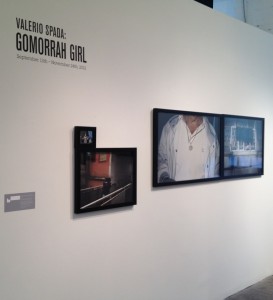In March of 2011, Italian photographer Valerio Spada released a self-published book entitled Gomorrah Girl. The book, which was received with immense praise and went on to become the grand prize winner of the 2011 Blurb Photobook Now competition, eloquently recounts the accidental murder of Annalisa Durante, using photographs and brief text descriptions. Annalisa, a 14-year old girl in the crime and drug ridden community of Naples, was shot in the head by a stray bullet meant for a Camorra (Mafia) mobster. The book narrates the story of Annalisa’s life and death through images of her family, neighbors and police reports on the tragedy. Annalisa’s death was just another heartbreaking example of common crime in this neighborhood, where girls are continuously and violently deprived of childhood and opportunity.

The U.S. debut of the show Gomorrah Girl, presenting select images from the award-winning book, can now be seen at the Philadelphia Photo Arts Center (PPAC). The exhibit compiles poignant photographic portraits revealing the hardship and misfortune in the life of an adolescent female in Naples, juxtaposed with a display table featuring 12 smaller images of the various police documents regarding Annalisa’s murder. Upon entering the gallery, you are faced directly with an intriguingly curated cluster of images, the most impactful of which is the cropped image of Giovanni Durante’s (Annalisa’s father) chest wearing a pendant that offers the only image of Annalisa to be found in the exhibit. The realization of the subject of the imagery becomes even more tragic upon closer examination of the text accompanying it. The text explains that every morning since the day she died Giovanni has brought breakfast with milk to his daughters’ grave. This gripping photo, reflecting the intense pain left in the wake of Annalisa’s murder, dictates the context of the exhibition and sets the mood for viewing the rest of Spada’s work.

The majority of the remaining images highlight some of those born into the same misfortune as Annalisa. These “Gomorrah Girls” range in age and situation, from eighteen year-old female boxing champion Viviana to a seemingly older woman under house arrest. Some of these portraits allude to a sense of positivity in the midst of tribulation, subtly suggesting a hope of eventual escape, while the faces of others exude hopelessness and mirror the utter despair of their environment. One thing that the pictures all do, however, is clearly and undoubtedly communicate the wretchedness of the community in which these girls were born and raised. Among the subjects of the emotionally charged portraits is a recurring character, Sabrina. At first glance, Sabrina appears to simply be a sassy eleven year-old. Further investigation reveals that she is a child star of a specific genre: she is a “neo-melodic” singer. Camorra families are sometimes behind this racket, and occasionally send messages to each other through the lyrics. There have also been several instances where the writers of these lyrics have been prosecuted for the pedophiliac nature of the words.

Among this collection of portraits are several photographs of other subjects. Although these works are object-based they still read as portraits and are equally revealing. One of these images, perhaps the most illuminating, is an image with a text translation of a letter written by a woman detained in a female prison in Pozzuoli. She pleads for help and describes her environment in grotesque detail, explaining the atrocious treatment of the inmates. It is impossible to imagine being so helpless and subjected to abuse in the United States, where prison is still much feared, although treatment of inmates anywhere close to what is described in the letter would not likely exist for long before an investigation or lawsuit.

If I had been asked about this show and its contents before seeing it, I would have been skeptical that any sort of rendering could even begin to emulate the duress that the Gomorrah Girls are born into, but Spada comes close. His portraits are not only expressive and extraordinarily moving and profound, but also aesthetically beautiful. His work is handsomely composed, both in individual photographs and in the exhibition space as a whole. He uses this series of striking images to portray a marginalized society filled with constant trials and anguish. Through the lens of photography, Spada transports the viewer to a place where adolescence is lost to a culture of violence, misogyny and abandon. The exhibition provides a long overdue social commentary on a society overrun by despondency and further blurs the already fine line between photojournalism and fine art.
The show is up at Philadelphia Photo Art Center to November 24th. More information can be found at PPAC‘s website, or at the artist’s website.
Adriana Rabinovitch is a Moore College of Art and Design student in Terri Saulin’s Critical Discourse class. Her post was selected to appear in artblog as part of the Culture in the Classroom program at Moore, in which Libby and Roberta participated as lecturers and as jurors to select one post from the class for publication.









